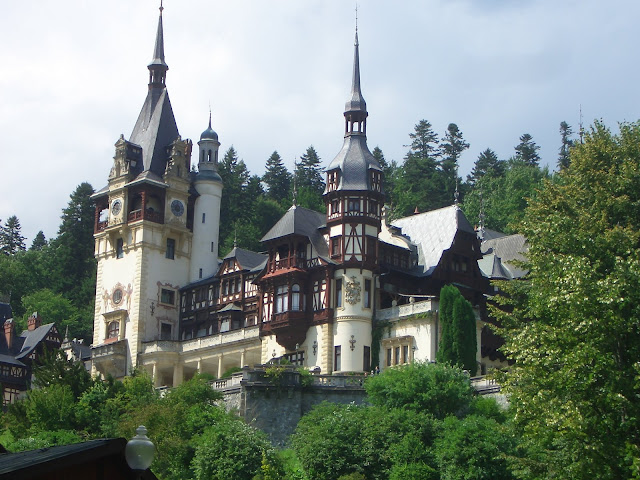Built in the late 1800's for King Carol the1st, the Castle is in the style of a Bavarian Schloss.
The Castle is named after the Peles river which flows nearby.
Peles was decorated by King Carol's eccentric wife Eiizabeta, who was also a popular novelist called Carmen Silva. Not one of the 160 rooms was decorated in Romanian style, but were embellished with walnut, ebony, leather, alabaster, French tapestries and mother of pearl .
The Castle is positioned in extensive gardens landscaped in the English style.
On arrival, the short English tour was not for another hour, so we joined the longer Romanian Tour. Everyone had to put slippers on, and mine were odd sizes and kept falling off when we went upstairs. We had to keep up with the group as the Guide waited until everyone was there before he spoke. Then I tried to pick up an occasional word of what he was saying, but mainly looked where everyone else was looking, then followed the crowd as I didn't have a clue as to what was going on.
A stained glass window with the sun shining through.
The Un Romanian interior of Peles Castle
An example of the art on display. Some of the originals are now exhibited in the National Art Museum in Bucharest.
The Courtyard at the entrance to the castle where we were shown out after taking photographs. Other people were taking photos, but we were remonstrated with more than once before being shown the door. Is it cos I is black/English?, I thought to myself, but we eventually discovered that there was an extra fee for taking photos, but as we were not asked (as far as we know) when we bought our tickets we did not know this.
So, I cannot show you the Murano glass chandeliers in the Florentine Hall, the carrera marble fountain in the Moorish Alhambra Hall or the Louis xiv room containing Romania's first cinema and paintings by the young Klimt. We didn't see the latter room ourselves, before we were ejected.
A lion guarding the Castle
Puppies living under a bush guarding the grounds?
Dogs living wild are a common sight and even live in the grounds of Peles Castle.
A secret door
A waterfall from the woods at Peles
A mysterious figure in the woods at Peles
A bride and groom posing for wedding photos outside Peles Castle
We have seen many brides and grooms when we are out and about on Saturdays. White weddings seem to be very popular.
For more information on Peles Castle, see
Slideshow of Sinaia: TravelPod’s trip to Sinaia, Romania was created by TripAdvisor. See another Sinaia slideshow. Take your travel photos and make a slideshow for free.
I hope you have enjo e trip to Peles Castle in Snaia.
Pa pa Anne-Marie





















